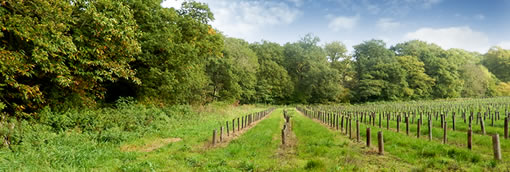 BIFoR - £15m for the ‘Biology Hadron Collider’
BIFoR - £15m for the ‘Biology Hadron Collider’
What will elevated CO2 levels do to our native woods in the long run? Biologists, ecologists and atmospheric scientists at Birmingham are excitedly looking forward to a Big Science experiment, designed to understand the effect of climate change in the UK. A gift of £15 million by Birmingham alumnus Professor Jo Bradwell has made it possible to construct a so-called FACE experiment (for Free Air Carbon dioxide Enrichment) in Shropshire. Barely perturbing the natural environment, FACE will study the long-term effect of elevated carbon dioxide on mature oak trees and surrounding fauna and flora.
BIFoR, the new Birmingham Institute for Forest Research, will gather researchers of the School of Biosciences, the School of Geography, Earth and Environmental Sciences and international experts. However, this is not only about trees. In BIFoR, ecology meets plant biology, zoology, microbiology and molecular biology. The project will give students in Biosciences direct insight into the complexities of ecology and great opportunities to participate in ground-breaking research.
Visit the BIFoR website
University develops 'Tricorder' to improve food safety
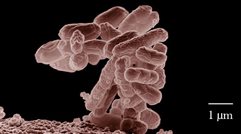 In 2011, an outbreak of Escherichia coli (E.Coli) disease in Germany claimed the lives of 53 people. The cause of the outbreak was eventually traced to sprouts grown in Germany from seeds sourced in Egypt.
In 2011, an outbreak of Escherichia coli (E.Coli) disease in Germany claimed the lives of 53 people. The cause of the outbreak was eventually traced to sprouts grown in Germany from seeds sourced in Egypt.
Now, a team of Scientists from the University of Birmingham is leading the emerging field of synthetic biological research to bring a Star Trek inspired 'tricorder' detector a step closer to reality with an initial focus on food safety.
Read more about this research here
Testing a low cost solution to nuclear waste disposal with partners in Fukushima, Japan
Since the 1950s, nuclear weapon and energy programmes have created a legacy of radioactive waste and contamination worldwide.In the UK alone, the safe disposal of legacy nuclear waste will cost £80 billion (est.) and take up to 100 years to complete. Nuclear disasters pose additional challenges.
To address the problem, researchers at the University of Birmingham have been working to translate more than 30 years of research into the development of a low cost solution for nuclear waste clean-up that innovatively employs the use of microbially-generated bio materials
Read more about this research
When the 'white knight' does not help
 Cryptococcus neoformans
Cryptococcus neoformans
Our immune system has evolved to fight off infectious diseases. Sadly, there are some infections, it can’t cope with – such as HIV. This virus kills mainly by opening the gate for other infectious agents that otherwise would do far less harm. And, as Biosciences Professor Robin May found recently, certain white blood cells of the immune system can even become complicit in promoting infections, rather than help fight them off. A significant fraction of HIV+ patients are co-infected with the fungal pathogen Cryptococcus neoformans (right). Together with colleagues at St.George’s Hospital, London, Professor May found that certain patients in this cohort have relatively high amounts of the fungus in their spinal fluid – a key indicator of likelihood of death. How did it get there? It turns out that white blood cells known as macrophages are the likely vehicle for transporting engulfed Cryptococcus across the blood-brain barrier into the central nervous system and the brain.
Robin May comments: “This appears to be a remarkable case of a pathogen ‘hijacking’ our immune system in order to spread around the body. By understanding more about the way they do this, we hope to ultimately be able to develop therapies that shut down this route of infection.”
 Professor Robin May teaches the third year module Molecular and Cellular Immunology
Professor Robin May teaches the third year module Molecular and Cellular Immunology
Professor May's profile
The May lab website
Feathers and fisheries
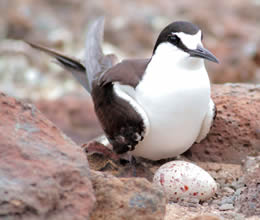
Photo by kind permission: Jim Porter
In Ernest Hemingway’s 1954 Nobel Prize-winning novel The Old Man and the Sea, the title character is “sorry for the birds, especially the small delicate dark terns that were always flying and looking and almost never finding…”. About the size of pigeons, Sooty Terns forage on small fish that have been driven to the ocean surface by large predatory fish such as tuna or marlin. On Ascension Island in the South Atlantic, Sooty Terns breed in vast colonies. At least, they used to. Over the last 60 years, their breeding population has declined by nearly 90%. In collaboration with the Army Ornithological Society, Biosciences’ Lecturer Dr Jim Reynolds is investigating why.
Jim tracks how dietary habits of the Sooty Terns are changing. Feathers from skins of birds collected on Ascension Island between 1876 and the present day – available in museum collections - hold a record of the birds’ diets over the last 138 years and their secrets can be unlocked using stable isotope analysis. It was possible to show that, over the last 60 years, the Sooty Terns’ prey has shifted towards lower food quality. One can infer from this finding that large tuna and marlin are far less abundant than they once were in the Atlantic, reflected by the collapse of fishery. This means breeding birds struggle to find the small fish they feed on. Sadly, the Sooty Tern population on Ascension Island shows few signs of recovery.
See Dr Jim Reynolds' profile
Time travel and genomics
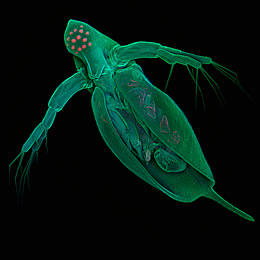
Photo by kind permission: Dr Jan Michels
(Christian-Albrechts-Universität zu Kiel)
In Steven Spielberg’s 1993 movie Jurassic Park, scientists revive creatures that became extinct millions of years ago. All science fiction? Yes, but Biosciences Professor John Colbourne and his co-workers did a similar experiment, digging in the sediments of South Center Lake in Minnesota, USA. In various layers of the lake’s sediment they found eggs of the water flea, scientifically known as Daphnia. According to radio-isotope analysis the oldest eggs were laid 700 years ago. Improbably, it was possible to hatch the eggs and extract DNA from the revived water fleas.
John Colbourne’s group sequenced these DNA samples and showed how the genome of Daphnia has changed over the centuries. One particular change occurred in the 1800s. Until then, the element phosphorus was very scarce in the lake, and Daphnia had developed a metabolism that held on tight to this essential nutrient. With industrialisation came phosphorous-rich wastewater, and a new strain of Daphnia emerged, better adapted to the higher phosphorous concentration of the modern era.
See the article in the New York Times
Platelets – a case of Jekyll and Hyde
The title Robert Louis Stevenson’s novella 'The strange case of Dr Jekyll and Mr Hyde' has become a popular metaphor for a ‘split personality’. A great example of human physiology with distinct Jekyll and Hyde traits is the platelet. The smallest cells in our blood stream, platelets are vital to control bleeding. But they are also responsible for clot formation in diseased blood vessels, causing heart attacks and strokes.
The British Heart Foundation (BHF) supports research into how platelets function, and how, ultimately, heart disease can be controlled or prevented. Among those supported by the BHF is Biosciences Lecturer Dr Mike Tomlinson. His group has recently discovered an enzyme that functions as a master switch in initiating clot formation. The enzyme, known as CD148, is embedded in the surface membrane of platelets, and its role is to prime platelets for rapid activation.
While conventional blood thinners can help prevent stroke and heart disease, they also increase the risk of excessive bleeding in tissue injury. In contrast, Dr Tomlinson’s research suggests that controlling CD148 activity could mean selectively preventing the blocking of blood vessels, without affecting bleeding.
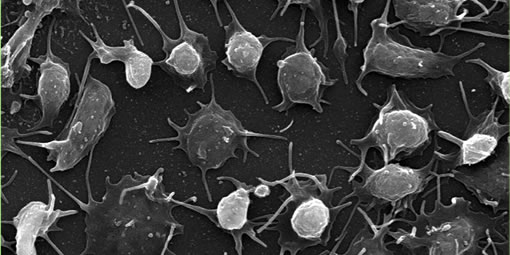
Platelets imaged by scanning electron microscopy (courtesy Dr Elizabeth Haining, a former PhD student with Mike Tomlinson)

Research in 60 seconds - video gallery